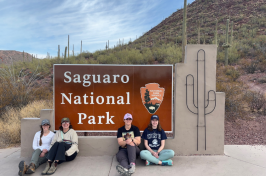
THE MOUTH OF THE MISSISSIPPI RIVER, EMPTYING INTO THE GULF OF MEXICO SOUTH OF NEW ORLEANS, LOUISIANA, IS PICTURED FROM THE INTERNATIONAL SPACE STATION AS IT ORBITED 262 MILES ABOVE. CREDIT: ROSCOSMOS/NASA.
Wetland restoration efforts along the Mississippi River are falling short of expectations to help fix the Gulf of Mexico's dead zone, according to new research from UNH.
Every year, excess fertilizer runs off agricultural farms along the Mississippi River and flows into the Gulf of Mexico, which reduces oxygen levels in the water and kills marine organisms; this is often called the Gulf's dead zone. Restoring wetlands along field-margins has long been proposed as a way to stop some of this overflow, but the UNH researchers found that current restoration programs are not reaching their expected goals. Instead of the intended reduction of 45%-60% of the damaging nitrates from the fertilizer ending up in the river, they found the nitrate export was only reduced, at most, by 30%.
“Restoring the wetlands is a good first step but the range in the amount of nitrogen potentially reduced by the restoration efforts can vary widely depending on other factors like the flow of groundwater, engineering constraints, seasonal differences and the location of the wetlands,” said Shan Zuidema, research scientist at UNH’s Earth System Research Center and lead author.
In their study, published in the journal PNAS Nexus, researchers used process-based physical modeling to evaluate two hypothetical wetland restoration strategies intended to reduce nutrient export to the Gulf of Mexico. They found that existing programs that focused on the construction of field-margin wetlands, with strips of land between the crops and the river, fell short for three reasons.
First, after water is contaminated by fertilizer it drains into the groundwater, making it harder for wetlands to intercept the fertilizer runoff. This lowers the opportunities for wetlands to reduce nitrogen export. The researchers point out that unlike previous studies, their models first constrained riverine fluxes to match observed fluxes throughout the basin. The second reason the policies are limited is the locations of many wetlands that could be restored. They are geographically disconnected from heavily fertilized croplands which limits their ability to help intercept the harmful runoff. And third, the model simulations took into account seasonal factors — like storms and rain — and how they can inhibit the wetland nutrient removal because peak time wetlands are able to mitigate the nitrate does not coincide with when the fertilizer is leaving the field.
“To improve the health of the Gulf of Mexico, efforts to eliminate excess nutrient loading should be implemented beyond the field-margin wetland strategies investigated here,” said Zuidema.
Researchers agree that field-margin wetlands are an important step towards mitigating the dead zone in the Gulf of Mexico because they have the capacity to reduce a meaningful fraction of nitrate and have existing conservation mechanisms in place to facilitate adoption. But they say other factors to consider are interventions to restoring fluvial wetlands, whose position in the watershed can mitigate more of the nitrogen actually reaching the coast. Future changes in both climate and cropping practices need to be considered to ensure feasibility of these approaches.
Co-authors include Wilfred Wollheim and Richard Lammers, both at UNH, and Christopher Kucharik, at the University of Wisconsin-Madison.
Funding for this research was provided by the National Science Foundation Innovations at the Nexus of Food, Energy and Water Systems project. Partial funding was provided by the New Hampshire Agricultural Experiment Station through the USDA National Institute of Food and Agriculture.
The UNH Institute for the Study of Earth, Oceans, and Space (EOS) is UNH's largest research enterprise, comprising six centers with a focus on interdisciplinary, high-impact research on Earth and climate systems, space science, the marine environment, seafloor mapping and environmental acoustics. With approximately 100 principal investigators managing more than 400 individual grant awards, and with annual expenditures exceeding $95 million, EOS fosters an intellectual and scientific environment that advances visionary scholarship and leadership in world-class and graduate education.
-
Written By:
Robbin Ray ’82 | UNH Marketing | robbin.ray@unh.edu | 603-862-4864



















































